Alton, Staffordshire, England, UK – Wednesday, June 23rd, 2010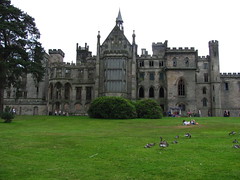
Alton Towers is the largest and most popular theme park in the United Kingdom, yet from London it is more difficult to reach than Disneyland Paris. It is located deep in the heart of Staffordshire upon the grounds of the former residence of the Earls of Shrewsbury, perhaps one of the beautiful landscapes in all of England… therefore making it one of the worst places in England to build a theme park. British parks are internationally renowned for having some of the densest and most difficult bureaucratic red tape to cut through to construct so much as a urinal on their own property let alone a roller coaster, and being built over pristine, hallowed ground has meant that Alton Towers’ struggle is always the most Sisyphean. Yet somehow the theme park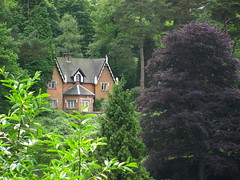 has made it to the 21st century as the industry’s existential hero, having made from their futile circumstances a destination playground that somehow manages world class.
has made it to the 21st century as the industry’s existential hero, having made from their futile circumstances a destination playground that somehow manages world class.
To reach the front gates without the aid of a personal automobile requires a rail journey to the somewhat proximate village of Stoke-on-Trent where some form of expensive overnight accommodations will be mandatory if one intends to arrive before opening while relying on the train schedules. From Stoke-on-Trent departs a singular city-owned bus no more frequent than each hour for Alton Towers, which would be crowded enough if only loaded with visitors but also seems to be the means of transportation for many of the Tower’s employees. (One wonders if they are now required to pay parking as well?) After a forty-five minute journey through winding country roads at times more dynamic than several of the roller coasters that await, we pull into our destination; although apart from a few scant signs the only way I could be sure we had arrived was the louder-than-usual commotion among my fellow wayfarers, so well hidden are the rides and structures below the tree line (due to a regulation so famous it even became a key challenge to a RollerCoaster Tycoon scenario). Apparently plans are underway to construct a train station at Alton Tower’s entrance to greatly simplify the ease of getting guests into the park (until then I wonder why a park-sponsored coach shuttle service is so difficult to implement) although in presenting their case for the local government’s approval they will apparently not rely so heavily
are now required to pay parking as well?) After a forty-five minute journey through winding country roads at times more dynamic than several of the roller coasters that await, we pull into our destination; although apart from a few scant signs the only way I could be sure we had arrived was the louder-than-usual commotion among my fellow wayfarers, so well hidden are the rides and structures below the tree line (due to a regulation so famous it even became a key challenge to a RollerCoaster Tycoon scenario). Apparently plans are underway to construct a train station at Alton Tower’s entrance to greatly simplify the ease of getting guests into the park (until then I wonder why a park-sponsored coach shuttle service is so difficult to implement) although in presenting their case for the local government’s approval they will apparently not rely so heavily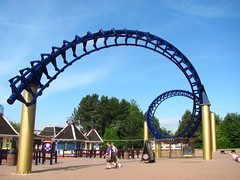 on economic and social benefits such a line would have for people today, but instead (this is true) emphasize that historically a train service did once run to the gardens before it became a theme park, and so they should resurrect that tradition as a “Heritage Railway”.
on economic and social benefits such a line would have for people today, but instead (this is true) emphasize that historically a train service did once run to the gardens before it became a theme park, and so they should resurrect that tradition as a “Heritage Railway”.
The humble port of entry has recently been redecorated with the recycled corkscrew from the eponymous defunct attraction, now in cobalt and gold. I admire this clever salute to a lost legend for only as long as it takes me to briskly speed walk under whilst en route to the ticket turnstiles to scan my Merlin Annual Pass, aware that time was preciously few and crowds were not. One of the primary benefits of this pass was an hour-long morning ride session on Nemesis, Thirteen and Oblivion,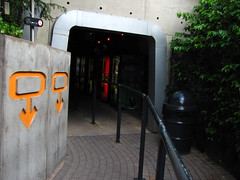 and I took some pleasure in the contradiction between my appearance as a confused, first-time foreign visitor and then producing some plastic certifying me as a ‘regular’ allowed to skip ahead the local standard ticket schmucks.
and I took some pleasure in the contradiction between my appearance as a confused, first-time foreign visitor and then producing some plastic certifying me as a ‘regular’ allowed to skip ahead the local standard ticket schmucks.
 Oblivion was to be virginal Alton Towers experience, and as the rest of the early entrants had elected to wait for Thirteen, it would also be my second, third and forth ride at Alton Towers within a period of about a half an hour, most of that time consumed by a complicated, spiraling queue pattern that needed re-traversing between each cycle. This queue sets the proper tone for the ride ahead, and I almost regretted getting to run right up to the loading platform. Ominous and paranoid, yet clearly a product of the late 90’s, within its industrial concrete shelters is a running video set to a syncopated techno soundtrack where the self-proclaimed Lord of Darkness calmly yet firmly explains the subconscious anxiety you are experiencing right now as you wait your turn standing next to teenagers playing Angry Birds on their iPhones. Why does he think we should be fearful?
Oblivion was to be virginal Alton Towers experience, and as the rest of the early entrants had elected to wait for Thirteen, it would also be my second, third and forth ride at Alton Towers within a period of about a half an hour, most of that time consumed by a complicated, spiraling queue pattern that needed re-traversing between each cycle. This queue sets the proper tone for the ride ahead, and I almost regretted getting to run right up to the loading platform. Ominous and paranoid, yet clearly a product of the late 90’s, within its industrial concrete shelters is a running video set to a syncopated techno soundtrack where the self-proclaimed Lord of Darkness calmly yet firmly explains the subconscious anxiety you are experiencing right now as you wait your turn standing next to teenagers playing Angry Birds on their iPhones. Why does he think we should be fearful?
At the time it was built, this was the world’s first vertical drop on a roller coaster; ‘vertical’ in this case implying 87°, but who’s counting? Certainly that was something impressive back in 1998, as even the most well-ridden coaster enthusiasts would not have a subjective point of reference for exactly what it would feel like to experience such a plunge until they were seated at the crest themselves, hence the video making numerous references to falling into the blackness or the unknown. The problem is that simply being a ‘world’s first’ is an intangible sensation, and as it certainly proved to not be the last the vertical drop isn’t really an unknown factor anymore. There are more models of roller coasters using vertical or beyond freefalls from competing than I’d care to count, and they’ve reduced the maneuver to an off-the-shelf product, often times steeper and with a whole slew of additional elements to give the layout more meat (Thorpe’s Saw: The Ride basically cuts Oblivion’s trains in half, pulls the drop 13° steeper, and fits a full dark ride and inversion-and-airtime-packed roller coaster before and after). The pressing question on my mind as I settled into the front row of seats was: is Oblivion still relevant in 2010?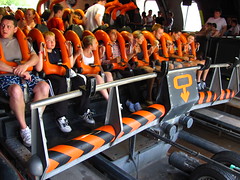
The main factor weighing against it is that it’s a one-trick pony and its trick has become outmoded. Despite that, there is still a sense of gravitas to that trick which is missing from the more extreme examples. The designers, engineers and everyone working on it seems to truly believe that an 87° drop is a big deal,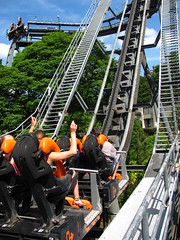 and so we sort of believe that too. Unlike other coasters that just yank you over the precipice whether you were ready or not, Oblivion spends a long time making sure that you’re ready, only to prolong the inevitable even further. This is why I was regretting not having to queue for my first ride, because that wait is most definitely intended to be part of the experience. The lift hill is slow, deliberately so, and when you get to the top, there’s an even slower curve, a funky sideways chainlift laid along the track catching the car to make sure we don’t arrive at our destination too quickly. We know the procedure our vehicle must take to get to the drop, we know the details of that drop (do you think it was an accident that the entrance is located just past the viewing area for the lift and drop?), yet we can’t resolve these tensions with the releasement from knowing what it will feel like to be ourselves falling into that tunnel.
and so we sort of believe that too. Unlike other coasters that just yank you over the precipice whether you were ready or not, Oblivion spends a long time making sure that you’re ready, only to prolong the inevitable even further. This is why I was regretting not having to queue for my first ride, because that wait is most definitely intended to be part of the experience. The lift hill is slow, deliberately so, and when you get to the top, there’s an even slower curve, a funky sideways chainlift laid along the track catching the car to make sure we don’t arrive at our destination too quickly. We know the procedure our vehicle must take to get to the drop, we know the details of that drop (do you think it was an accident that the entrance is located just past the viewing area for the lift and drop?), yet we can’t resolve these tensions with the releasement from knowing what it will feel like to be ourselves falling into that tunnel.
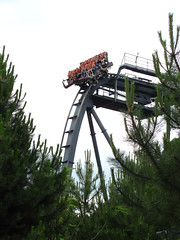 The holding chain keeps us perched on the edge, our shuttle already tipped forward about halfway to vertical, we are at the big moment and yet time has stopped. Despite not even being above the tree line on a 65 foot tall lift, I cannot forget that this is nearly a hypercoaster, the narrow black maw continuing underground for a total dropping distance of 180 feet. That tunnel is where Oblivion still stands apart from the crowd. When I think of a tunnel on a roller coaster I think of a little trench dug out with a concrete roof laid over it and some dirt and grass sprinkled on top, not carving halfway into the earth’s mantle. That’s the ‘unknown’ factor for me; what does it feel like to keep diving that far underground?
The holding chain keeps us perched on the edge, our shuttle already tipped forward about halfway to vertical, we are at the big moment and yet time has stopped. Despite not even being above the tree line on a 65 foot tall lift, I cannot forget that this is nearly a hypercoaster, the narrow black maw continuing underground for a total dropping distance of 180 feet. That tunnel is where Oblivion still stands apart from the crowd. When I think of a tunnel on a roller coaster I think of a little trench dug out with a concrete roof laid over it and some dirt and grass sprinkled on top, not carving halfway into the earth’s mantle. That’s the ‘unknown’ factor for me; what does it feel like to keep diving that far underground?
One: These thoughts don’t get to fester for long, as the vehicle slips off the chain after two seconds or less and starts the downward plunge before the iconic “Don’t Look Down” voice could be heard. That was what the entire suspense was suppose to climax with, and now my first thoughts on what should be the big payoff is that I’ve already been cheated out of some of the experience I’d heard promised for twelve years.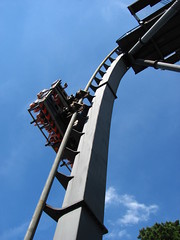
Two: A ninety-degree freefall by itself really isn’t much better than a drop tower and I don’t hold those in very high regard by any thrill ride aesthetic criteria. What makes a roller coaster drop better than a freefall tower drop is the accelerating forward curvature as you approach the steepest angle, not simply going down the steepest angle itself. The changing orientation with earth is what makes your inner ear prick up and scream; when you’re freefalling inline you literally don’t feel anything. Since the apex of Oblivion’s descent is so sharp, you basically start from the top already oriented straight down and you’re missing that entire flavor that normally makes a good first drop so rich. I write these words a bit jaded towards most drops being well familiarized with Cedar Point’s collection of Intamin’s coasters. The only thing Oblivion has that theirs don’t is the tunnel, which brings me to…
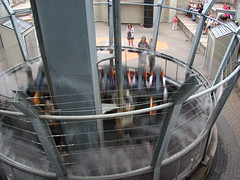 Three: Mist in the mouth of the tunnel entrance. Get rid of it. It looks cool from offride but I always had to wince when cutting through it and this distracts from where the rider’s focus should be placed. For me this was especially annoying as the moisture would instantly fog my glasses so I lost perspective on where I was in the tunnel. Then I’m thinking “ack, I’ve got to clean my glasses off,” which I think is an instinctual-neurotic response most spectacled people share. Eventually I took them off altogether, but then I had the nearly as annoying instinctual-neurotic response “ack, my eyes feel strained because everything I see is unfocused.” Perhaps I should get contacts.
Three: Mist in the mouth of the tunnel entrance. Get rid of it. It looks cool from offride but I always had to wince when cutting through it and this distracts from where the rider’s focus should be placed. For me this was especially annoying as the moisture would instantly fog my glasses so I lost perspective on where I was in the tunnel. Then I’m thinking “ack, I’ve got to clean my glasses off,” which I think is an instinctual-neurotic response most spectacled people share. Eventually I took them off altogether, but then I had the nearly as annoying instinctual-neurotic response “ack, my eyes feel strained because everything I see is unfocused.” Perhaps I should get contacts.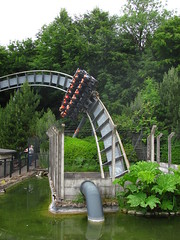
That was the drop and tunnel I experienced. It was kind of lame. I wanted to rank Oblivion highly because it was a creative ride with a singular vision that spared no expense in its execution (save for maintenance of some effects in recent years), but it was still a one-trick pony whose only trick wasn’t relevant in an age when the “world’s first” claim makes it feel antiquated rather than cutting-edge. The back row may have been a bit better for the crest of the drop and shielding a bit of the mist but Oblivion is still fundamentally a front-seat ride. Actually, my favorite part of the layout may have been the overbanked turn after the tunnel while sitting on the far left side, as with eight seats per row you’re far enough away from the intended heartline path that you get some funky dynamics from the quick rotation. There’s a small crest into the brake run, which reminds me what a good idea magnetic brakes are for high-speed deceleration in their absence.
Here’s a good idea for revitalizing Oblivion: turn the second row of seats around backwards. I’m serious. This would achieve several things.  First, every seat is now a ‘front-row seat’. Second, it will offer two distinctly different experiences within the same coaster, which increases the value of a park ticket for visitors. Third, the anticipatory suspense leading up to the drop will be heightened as riders won’t be able to see how close they are to the edge, only how far they’ve left the comfort of the station behind. Fourthly, and this I think is the most important reason for the change, is that no one’s ever done a backwards vertical plunge on a continuous circuit coaster before. The sensation of falling forward is all we ever gotten to experience on roller coasters and we’re fairly used to it. Our inner ears are adjusted to it whenever we drop a pencil or navel gaze. Falling backwards, on the other hand, is precisely that one sensation that millions of years of evolution have spent hardwiring our brains to go on red-alert when it happens
First, every seat is now a ‘front-row seat’. Second, it will offer two distinctly different experiences within the same coaster, which increases the value of a park ticket for visitors. Third, the anticipatory suspense leading up to the drop will be heightened as riders won’t be able to see how close they are to the edge, only how far they’ve left the comfort of the station behind. Fourthly, and this I think is the most important reason for the change, is that no one’s ever done a backwards vertical plunge on a continuous circuit coaster before. The sensation of falling forward is all we ever gotten to experience on roller coasters and we’re fairly used to it. Our inner ears are adjusted to it whenever we drop a pencil or navel gaze. Falling backwards, on the other hand, is precisely that one sensation that millions of years of evolution have spent hardwiring our brains to go on red-alert when it happens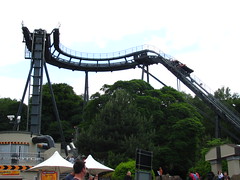 and that is not likely to be overcome simply with an exclusive ride session. I find it surprising – nay, shocking – that ride designers have not thought to exploit this biological impulse for their own nefarious purposes, and seems like a scheme Alton Towers would eat up given their predilection to pop-psychologizing even the most mundane aspects of their thrill rides to make up for the fact that they’re mostly not very big or fast. However, given what weenies B&M are over even the slightest modifications that don’t fit their original specifications for rider-experienced force it might be difficult to convince them to sign off on such a project.
and that is not likely to be overcome simply with an exclusive ride session. I find it surprising – nay, shocking – that ride designers have not thought to exploit this biological impulse for their own nefarious purposes, and seems like a scheme Alton Towers would eat up given their predilection to pop-psychologizing even the most mundane aspects of their thrill rides to make up for the fact that they’re mostly not very big or fast. However, given what weenies B&M are over even the slightest modifications that don’t fit their original specifications for rider-experienced force it might be difficult to convince them to sign off on such a project.
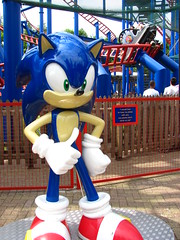 Of course, if such a redesign was necessary to fulfill a lucrative brand tie-in then there’s no hesitation in undertaking roller coaster redesigns. The new Sonic Spinball is 2010’s reimagining of the slightly less new Spinball Whizzer, a Maurer spinning coaster installed as a sister project to Chessington’s Dragon’s Fury in 2004. As far as reimaginings go the formula here was pretty simple: paint the salmon red track and teal blue supports to red track and blue supports, add a few props licensed from Sega to replace the old pinball theme, change the name, and issue a press release.
Of course, if such a redesign was necessary to fulfill a lucrative brand tie-in then there’s no hesitation in undertaking roller coaster redesigns. The new Sonic Spinball is 2010’s reimagining of the slightly less new Spinball Whizzer, a Maurer spinning coaster installed as a sister project to Chessington’s Dragon’s Fury in 2004. As far as reimaginings go the formula here was pretty simple: paint the salmon red track and teal blue supports to red track and blue supports, add a few props licensed from Sega to replace the old pinball theme, change the name, and issue a press release.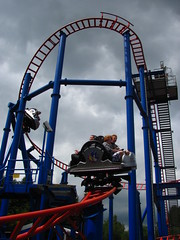 (Guess which one of these steps is the most important.)
(Guess which one of these steps is the most important.)
I like the idea of having a game themed coaster and was a bit disappointed that Sonic Spinball was little more than a roller coaster themed to a property that’s originally from a game. Interactivity is a term I generally want to keep as far away from great roller coasters as possible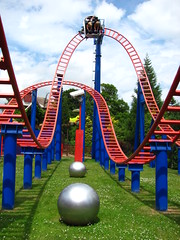 but in the context of a ride like this I think it would be an interesting experiment to fuse ‘games’ and ‘rides’ together, even if it’s done before you get to the chain lift. Games and theme parks are two mediums that are right now on the cusp of making a breakthrough into the world of art, provided they’re able to overcome some key philosophical dilemmas that neither industry is willing to confront as long as their current business models are still successful. The main aesthetic obstacle facing games is the issue of interactivity versus authorial control, while roller coasters have the issue of adrenaline usurping contemplation… but this all is a topic for another time, hopefully once memories of Sonic Spinball have long been forgotten. (For those interested in reading more on the games-side of this discussion, here’s a great article by Brian Moriarty examining
but in the context of a ride like this I think it would be an interesting experiment to fuse ‘games’ and ‘rides’ together, even if it’s done before you get to the chain lift. Games and theme parks are two mediums that are right now on the cusp of making a breakthrough into the world of art, provided they’re able to overcome some key philosophical dilemmas that neither industry is willing to confront as long as their current business models are still successful. The main aesthetic obstacle facing games is the issue of interactivity versus authorial control, while roller coasters have the issue of adrenaline usurping contemplation… but this all is a topic for another time, hopefully once memories of Sonic Spinball have long been forgotten. (For those interested in reading more on the games-side of this discussion, here’s a great article by Brian Moriarty examining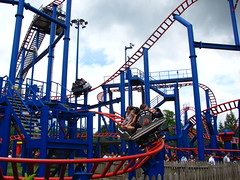 the “Games are Art” controversy instigated by Roger Ebert.)
the “Games are Art” controversy instigated by Roger Ebert.)
Apparently everyone in the UK travels to theme parks on a buddy system, which would explain why there were hardly any odd-numbered groups to provide a seat to a short but patient single-rider queue. The coaster is very much like any other spinner out there, and call me crazy but I prefer the progression and altered pacing of the basic wild mouse design supplied by Reverchon and Zamperla over the ‘advanced’ helices and swooping patterns supplied by Maurer and Gerstlauer, which always seem meandering and random, and the spinning generally slows down and becomes a gimmick to add further confusion and ambiguity to the experience. It was a fairly toothless ride as well,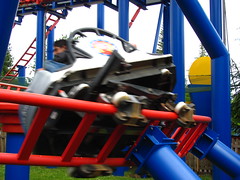 I recall a few flat box turns around the block brakes were some of the most jarring moments along with a decent s-curving drop halfway through. The rest pales in comparison to the custom layout of Dragon’s Fury, which at least seemed integrated with its landscape and not like it was a garish, loud carnival ride built over a former picnic field. It at least fits Alton Towers as their only big family thrill coaster… at least, marketed as a family thrill coaster.
I recall a few flat box turns around the block brakes were some of the most jarring moments along with a decent s-curving drop halfway through. The rest pales in comparison to the custom layout of Dragon’s Fury, which at least seemed integrated with its landscape and not like it was a garish, loud carnival ride built over a former picnic field. It at least fits Alton Towers as their only big family thrill coaster… at least, marketed as a family thrill coaster.
As I walked down the exit ramp I found standing in wait a lanky, mop-headed young man wearing a notably colorful Dueling Dragons tie-dye shirt. After a brief moment of unsure eye-contact, we quickly approached each other and made introductions, and barely seconds later we were deep in nerdversation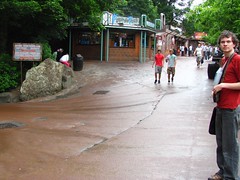 as if we had always known each other. This was Sam, a native of Nottingham and from my understanding a fairly well-known personality on a number of UK park fan sites. After I had published my essay on the Beast I received an email from Sam professing his enjoyment of my writing and adamant to reveal to me the hidden secrets of the Ultimate, which for reasons stated in that review was why I did not even finish reading my first piece of fan mail, but replied thanking him for his insights nevertheless and made mention that I was in fact planning to visit the UK in the near future. Thus is the story of how I got a free personal tour guide during my two days at Alton Towers, and after weeks of traveling solo it was great to finally have someone to talk to in the interminable queues.
as if we had always known each other. This was Sam, a native of Nottingham and from my understanding a fairly well-known personality on a number of UK park fan sites. After I had published my essay on the Beast I received an email from Sam professing his enjoyment of my writing and adamant to reveal to me the hidden secrets of the Ultimate, which for reasons stated in that review was why I did not even finish reading my first piece of fan mail, but replied thanking him for his insights nevertheless and made mention that I was in fact planning to visit the UK in the near future. Thus is the story of how I got a free personal tour guide during my two days at Alton Towers, and after weeks of traveling solo it was great to finally have someone to talk to in the interminable queues.
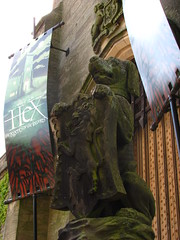 Sam suggested we head to Hex: The Legend of the Towers next, naming it as his second-favorite attraction in the park and one of John Wardley’s finest hours. With that description I certainly wasn’t going to argue against it. The attraction is set in the actual ruins of Alton Towers, and as Sam explained during the preshow located in the armory, the storyline is based on an actual legend, in which the 15th Earl of Shrewsbury denied a coin to an old beggar woman, who then placed a curse upon him that whenever the branch of a nearby oak tree would fall, a member in his family would die (let this serve as a warning to all supply side economists). Of course the curse came true, and so to prevent any more deaths the Earl had the tree chained up, which according to Sam you can still visit just outside the main gates to this day, which perhaps explains why the storyline so far
Sam suggested we head to Hex: The Legend of the Towers next, naming it as his second-favorite attraction in the park and one of John Wardley’s finest hours. With that description I certainly wasn’t going to argue against it. The attraction is set in the actual ruins of Alton Towers, and as Sam explained during the preshow located in the armory, the storyline is based on an actual legend, in which the 15th Earl of Shrewsbury denied a coin to an old beggar woman, who then placed a curse upon him that whenever the branch of a nearby oak tree would fall, a member in his family would die (let this serve as a warning to all supply side economists). Of course the curse came true, and so to prevent any more deaths the Earl had the tree chained up, which according to Sam you can still visit just outside the main gates to this day, which perhaps explains why the storyline so far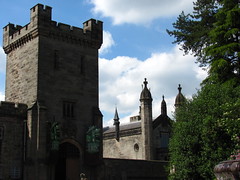 hasn’t been the standard, prepackaged narrative of A Science Experiment Gone Horribly Wrong Results in Pyrotechnics and/or Motion Sickness.
hasn’t been the standard, prepackaged narrative of A Science Experiment Gone Horribly Wrong Results in Pyrotechnics and/or Motion Sickness.
Whoops, I spoke too soon. The lights in the chamber dim as the voice explains to our intrepid group of chattering chavs that we’re about to be lead into a newly discovered laboratory where the Earl did experimentations on the fallen branch to discover the secret of the curse… we can be assured that nothing scary or nausea-inducing will subsequently happen. Meanwhile Sam was conducting the special effects, taking note whenever one missed its cue.
“There used to be some rain and lightning effects here, they’ve been taken down since last season.”
“Ah,” I nodded thoughtfully, trying not to be too distracted by the numerous glowing videophones in what should have been a pitch dark room.
“Maybe we’ll get the cold gust of wind… nope, not this time. It really is a brilliant ride.”
I agreed few other themed attractions required so much imagination to get the complete experience. The next chambers got even better in this regard, as we stared facing an empty stone wall.
“Okay, so here is where the curse would open an interdimensional portal that was achieved using an advanced antimatter particle accelerator behind us. You would climb through the portal and find yourself trapped within the nether-realm of pure reasoning and ideas. A legion of harpies would appear and engage in a ritualistic dance of the macabre, whom Wardley crafted by splicing together the genetic material of a Tawny Eagle with Morwenna Angove, and you could escape only through enlightenment after meditating on the eternal state of suffering all finite and mortal Beings must endure. But the antimatter generator jammed and the harpies tried to unionize so now they just load us all into a Vekoma Madhouse and turn the lights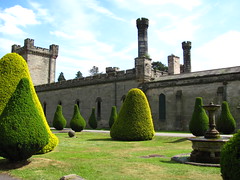 on and off for five minutes. It’s still a fantastic ride.”
on and off for five minutes. It’s still a fantastic ride.”
These rotating chamber rides have never really worked for me. Maybe the seating area takes up too much of my field of vision to trick my eyes but I never feel like I’m going upside down, I feel like I’m sitting inside a rotating drum on a platform that tips back and forth by 15°. I don’t recall many additional interior effects that left any solid impression on me either; after it was over I asked if their ‘magical table’ effect had also broke, recalling the lone eyebrow-raising moment in Parque Warner Madrid’s Hotel Embrujado, but that was never part of Hex’s design. To be clear I liked the idea and set design of Hex, especially the integration of authentic elements of Alton Tower’s history and location. 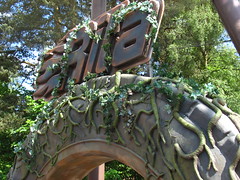 And I appreciated the attempt to craft a dramatic storyline that went beyond the shallow depths of most similar theme park ride-shows, but if I want to be told a compelling story that’s what the theatre and cinema are for; rides have their own unique aesthetic capabilities, and Hex is neither Nemesis nor Nosferatu.
And I appreciated the attempt to craft a dramatic storyline that went beyond the shallow depths of most similar theme park ride-shows, but if I want to be told a compelling story that’s what the theatre and cinema are for; rides have their own unique aesthetic capabilities, and Hex is neither Nemesis nor Nosferatu.
A good thing no attempt was made to untangle the storyline behind Rita, which originally had an innuendo-leaden drag race theme, apparently integrated with a Flintstones-like setting, but now it’s been abandoned and overtaken by the Dark Forest so the sexy silhouette racing logo design is now weathered and overtaken by vines, resulting in an appearance that’s slightly less schizophrenic than Syd Barrett (although Alton Towers would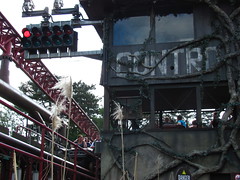 probably claim that the sex and death impulses are intrinsically linked and this new theme plays on those unconscious desires so we’re secretly terrified without our own realizing it before even entering the queue). I was surprised to learn that Rita isn’t part of the John Wardley canon and wasn’t even given ‘Secret Weapon’ status during development, which perhaps explains why it’s often looked down upon by fans as there’s little to no backstory or creative integration with the park’s landscape. I personally think that the greatest tragedy of Rita is that its presence precludes the opportunity for better launched thrill coasters to be developed at Alton Towers. Certainly we could expect miraculous things should Wardley ever decide to order a Blitz coaster from Intamin’s catalogue and with their height limitations a launched design is exactly what they could use to
probably claim that the sex and death impulses are intrinsically linked and this new theme plays on those unconscious desires so we’re secretly terrified without our own realizing it before even entering the queue). I was surprised to learn that Rita isn’t part of the John Wardley canon and wasn’t even given ‘Secret Weapon’ status during development, which perhaps explains why it’s often looked down upon by fans as there’s little to no backstory or creative integration with the park’s landscape. I personally think that the greatest tragedy of Rita is that its presence precludes the opportunity for better launched thrill coasters to be developed at Alton Towers. Certainly we could expect miraculous things should Wardley ever decide to order a Blitz coaster from Intamin’s catalogue and with their height limitations a launched design is exactly what they could use to stay competitive, but with Rita in place such an attraction would appear redundant.
stay competitive, but with Rita in place such an attraction would appear redundant.
Putting all of that aside, I liked Rita. It’s fast-paced and forceful, a description only one other coaster inside the park can truly lay claim to. Something about the launch makes it more suspenseful than other similar rides, perhaps because it sets off directly from the loading platform where you get to watch the reactions of riders on previous trains blast off to 60mph in 2.2 seconds with very little warning. Eschewing the traditional tophat at the end of the launch track, it instead makes a very intense rotation into a right banked curve which sustains some strong positive g-forces, all taken together to produce an extremely dynamic initial three seconds, sharply contrasting with the calm serenity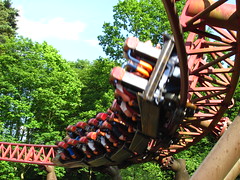 of sitting in wait on the loading platform mere moments before. On few other rides do we leave the ordinary world of waiting behind and enter the realm of pure visceral experience as suddenly as on Rita, and that transition is without question the coaster’s emotional core. Would it have been as effective without the deadly boring queue or with a preshow ‘preparing’ us for the launch ahead? Somehow, I think not.
of sitting in wait on the loading platform mere moments before. On few other rides do we leave the ordinary world of waiting behind and enter the realm of pure visceral experience as suddenly as on Rita, and that transition is without question the coaster’s emotional core. Would it have been as effective without the deadly boring queue or with a preshow ‘preparing’ us for the launch ahead? Somehow, I think not.
After the first few seconds of shock from the rapid velocity changes wear off the rest of the layout seems a bit more perfunctory but is nevertheless still thrilling if only due to the high speed. It traces one and a half figure eights with each of the banking transitions rising up for a pop of airtime. As could be expected it’s more interesting when it’s changing directions, in this case because the rotation of the vehicle’s pitch interacts with the weightlessness on the crest of the hill so depending on which side of the train you’re sitting on you get a slightly different experience. There’s marginally more substance than Stealth with a pattern of three repetitions with variations (each slightly less effective than the previous), although that’s not enough substance when we arrive at the first stretch of magnetic brakes leading into the banked S-turnaround back to the station. I eventually concluded that Rita may have been the second most exciting and instantaneously gratifying roller coaster at Alton Towers, yet paradoxically also the second most forgettable after Spinball (not counting the powered or kiddie coasters). It may stand out among the others for being fueled purely by adrenaline, but since that isn’t one of the Tower’s core capabilities anyway it still pales in comparison to likeminded attractions at other parks.
may have been the second most exciting and instantaneously gratifying roller coaster at Alton Towers, yet paradoxically also the second most forgettable after Spinball (not counting the powered or kiddie coasters). It may stand out among the others for being fueled purely by adrenaline, but since that isn’t one of the Tower’s core capabilities anyway it still pales in comparison to likeminded attractions at other parks.
Thirteen was next, but after a 90+ minute queue the psychological suspense caused my brain to partially meltdown when we entered the crypt and so I’d have to return to review it the next day. A bit farther yonder (although obviously outside the Dark Forest’s perimeter… I think) was Charlie and the Chocolate Factory: The Ride. The main unique selling point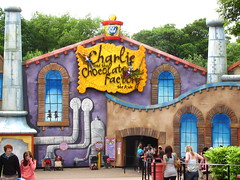 about this dark ride is that it’s really two separate rides combined into one. The first part is a rather slow and soporific boat ride but with some nice practical sets, while the second part is a more energetic simulator ride in the glass elevator that begins to grow drearisome after looking at the projected screens with kind of crappy animation while bouncing around for five minutes. Lots of 2D cartoon cutouts abound in this attraction, and Sam informed me that the original Toyland Tours was the higher quality attraction because Alton
about this dark ride is that it’s really two separate rides combined into one. The first part is a rather slow and soporific boat ride but with some nice practical sets, while the second part is a more energetic simulator ride in the glass elevator that begins to grow drearisome after looking at the projected screens with kind of crappy animation while bouncing around for five minutes. Lots of 2D cartoon cutouts abound in this attraction, and Sam informed me that the original Toyland Tours was the higher quality attraction because Alton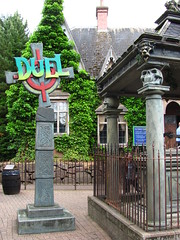 Towers blew half their makeover budget on acquiring the rights to the book. I’m always curious why these sorts of licensing agreements seem to forge competitive relationships like this, it seems it would be in the licensee’s interest to collaborate and contribute as much as they can during the development so the attraction that will be promoting their brand is in no way compromised, and after their synergy is successful they can both benefit much more from the rewards. It was the same story with Hard Rock Park, only that one was met with a crueler fate beyond mere mediocrity.
Towers blew half their makeover budget on acquiring the rights to the book. I’m always curious why these sorts of licensing agreements seem to forge competitive relationships like this, it seems it would be in the licensee’s interest to collaborate and contribute as much as they can during the development so the attraction that will be promoting their brand is in no way compromised, and after their synergy is successful they can both benefit much more from the rewards. It was the same story with Hard Rock Park, only that one was met with a crueler fate beyond mere mediocrity.
On the other side of the park is Duel, sadly not a film by Steven Spielberg but rather an interactive shooter dark ride themed to a haunted house overrun by zombies. I’m not sure what it was like before ‘interactivity’ became part of the rides description but I’m going to guess that I would have liked the original better. Even if you could get rid of the blinking targets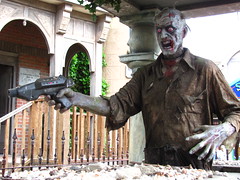 and constant noise of the guns, the use of laser shooters invariably turns the attraction into an arcade game. That’s a perfectly acceptable form of entertainment and some rides manage this well, but proper dark rides with individual vehicles allowing for scenes to be set up and presented directly to the riders are few and far between, and it seems a waste to allow such carefully constructed scenes and props to go unnoticed once plastic guns are placed in the riders hands, when an omnimover system in a warehouse with 2D glow-in-the-dark sets could accommodate more people to the same effect.
and constant noise of the guns, the use of laser shooters invariably turns the attraction into an arcade game. That’s a perfectly acceptable form of entertainment and some rides manage this well, but proper dark rides with individual vehicles allowing for scenes to be set up and presented directly to the riders are few and far between, and it seems a waste to allow such carefully constructed scenes and props to go unnoticed once plastic guns are placed in the riders hands, when an omnimover system in a warehouse with 2D glow-in-the-dark sets could accommodate more people to the same effect.
Nearby is a the Runaway Mine Train, sadly not of the classic ground-hugging Arrow Dynamics variety (which would have been both an awesome use of their landscape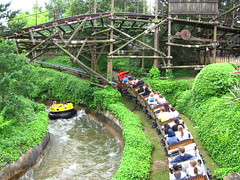 and a reliably high-throughput attraction) but a powered coaster by Mack using a single train that sends you around twice. According to Sam, the biggest draw for fans isn’t even the ride itself but its operator, who bids each trainload farewell with a hyper-sexualized ‘choo-choo…’ among other lavish commentary. Sadly she was not on-duty that day, but her replacement did an admiral job trying to fill her shoes. The ride itself I found to be quite short and boring in comparison to the long gravity-powered mine trains back home, but it was faster and more coaster-like than other European powered coasters and a highlight was a tunnel shared with the nearby rapids ride.
and a reliably high-throughput attraction) but a powered coaster by Mack using a single train that sends you around twice. According to Sam, the biggest draw for fans isn’t even the ride itself but its operator, who bids each trainload farewell with a hyper-sexualized ‘choo-choo…’ among other lavish commentary. Sadly she was not on-duty that day, but her replacement did an admiral job trying to fill her shoes. The ride itself I found to be quite short and boring in comparison to the long gravity-powered mine trains back home, but it was faster and more coaster-like than other European powered coasters and a highlight was a tunnel shared with the nearby rapids ride.
As the queue was not too long Sam suggested we give the Congo River Rapids a try as we were walking by. My relationship with water rides are often strained between appreciating them for combining elements of roller coasters and dark rides into an experience that usually lasts twice as long as either, and disdain for whenever they leave me with soaked clothing afterward, which tends to rub my skin raw if they don’t dry out quickly enough. To Sam’s assurance it shouldn’t be very wet at all so I said why not? The Congo Rapids featured an extremely pleasant setting along marshes and through ivy-covered valleys; not exactly fitting the African theme but who really cares? “Congo Rapids” is such an off-the-shelf name anyway that it doesn’t carry any social or cultural context any more besides to point out the type of amusement ride it is. This meant that the ‘rapids’ part of the title was also mostly absent from the attraction save for two wave makers near
My relationship with water rides are often strained between appreciating them for combining elements of roller coasters and dark rides into an experience that usually lasts twice as long as either, and disdain for whenever they leave me with soaked clothing afterward, which tends to rub my skin raw if they don’t dry out quickly enough. To Sam’s assurance it shouldn’t be very wet at all so I said why not? The Congo Rapids featured an extremely pleasant setting along marshes and through ivy-covered valleys; not exactly fitting the African theme but who really cares? “Congo Rapids” is such an off-the-shelf name anyway that it doesn’t carry any social or cultural context any more besides to point out the type of amusement ride it is. This meant that the ‘rapids’ part of the title was also mostly absent from the attraction save for two wave makers near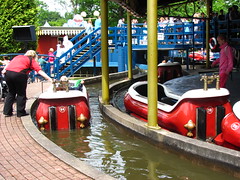 the beginning and end of the ride, and a series of waterfalls that looks like they get really close to drenching you wet but are still far enough away that they only make you look like a total wuss in front of your friends when they come thundering behind you.
the beginning and end of the ride, and a series of waterfalls that looks like they get really close to drenching you wet but are still far enough away that they only make you look like a total wuss in front of your friends when they come thundering behind you.
The Flume promised to be an even safer option in terms of wetness, and at first seemed even more rewarding with a long channel built in the verdant green canopies away from the hustle of the rest of the park, for me bringing back memories of Cedar Point’s long-gone White Water Landing. Then we entered a tunnel at the apex of a second lift, and all I recall after that point was emerging from the last big drop with Sam swearing up and down that it’s never been that wet before… and he was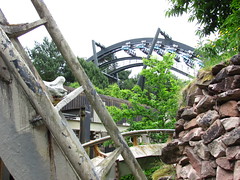 also pretty sure those squirting fountains at the very end were new, too. Once you resolve to the fact that, “yes, I am now wetter than I wanted to be,” the humor in the situation became readily manifest.
also pretty sure those squirting fountains at the very end were new, too. Once you resolve to the fact that, “yes, I am now wetter than I wanted to be,” the humor in the situation became readily manifest.
I once saw a television program that featured John Wardley discussing his philosophy for creating rides, and what he said seemed remarkably perceptible to me at the time: “When I create a ride, my ultimate goal is the end result. To give people a thrilling, exciting, amazing experience, and that experience is something that we determine in the brief of the design of the ride. So we might be wanting to give people a scary experience or an intimidating one; we might want to enchant them, to baffle them. All these emotions are emotions that other forms of entertainment manipulate, whether you’re in the theatre or film industry, or us in the theme park industry, we are doing the same thing: we are playing with people’s emotions, and giving people an entertaining time.”
manipulate, whether you’re in the theatre or film industry, or us in the theme park industry, we are doing the same thing: we are playing with people’s emotions, and giving people an entertaining time.”
After hearing this, I thought to myself: he gets it. He gets that the blue sky development of an attraction is more than a question of how to configure the hardware. Fundamentally, the question is about how you manipulate the subjective experience of your patrons in a way that is similar, if not identical to, other art forms. Even more refreshing was the idea he presented that a roller coaster need not be limited to a narrow range of emotion but could potentially inspire a multitude of new ride sensations. I wondered if it possible to build a comedic roller coaster, or a tragic roller coaster, or a romantic roller coaster? Perhaps that’s going a bit too far, but that doesn’t mean that other aesthetic possibilities aren’t open to exploration. After harnessing the singular sensation of vertigo with Oblivion a few years prior, it seemed his next would take this philosophy to even further extremes when Wardley envisioned a roller coaster that discarded the axiom that the quality of a coaster experience is tantamount to the received adrenaline rush, but instead provided riders with a sensation that tapped into the exuberance of pure freedom. Thus he devised the concept of a Flying Coaster with B&M, and in 2002 the world received a fresh breath of Air.
other art forms. Even more refreshing was the idea he presented that a roller coaster need not be limited to a narrow range of emotion but could potentially inspire a multitude of new ride sensations. I wondered if it possible to build a comedic roller coaster, or a tragic roller coaster, or a romantic roller coaster? Perhaps that’s going a bit too far, but that doesn’t mean that other aesthetic possibilities aren’t open to exploration. After harnessing the singular sensation of vertigo with Oblivion a few years prior, it seemed his next would take this philosophy to even further extremes when Wardley envisioned a roller coaster that discarded the axiom that the quality of a coaster experience is tantamount to the received adrenaline rush, but instead provided riders with a sensation that tapped into the exuberance of pure freedom. Thus he devised the concept of a Flying Coaster with B&M, and in 2002 the world received a fresh breath of Air.
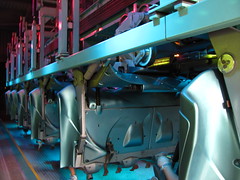 It was somewhat to my surprise then that Sam, who was generally enthusiastic about all things Alton Towers and especially enthusiastic about all things John Wardley, seemed ambivalent at best about Air. As he explained to me, the sensation of flying might be valid if they didn’t also forget it had to be at least a little bit exciting at all. The sleek metallic presentation and New Age station music were apparently not even Wardley’s invention; he originally wanted an intricate stealth fighter theme but the budget got scrapped and so frustrated was he that he didn’t return to consult on the creation of Rita three years later. If this is true, here I think he doesn’t get it: the minimalist theme works precisely because it doesn’t require us to perceive the ride as anything other than what it is. When the train moves into the flying
It was somewhat to my surprise then that Sam, who was generally enthusiastic about all things Alton Towers and especially enthusiastic about all things John Wardley, seemed ambivalent at best about Air. As he explained to me, the sensation of flying might be valid if they didn’t also forget it had to be at least a little bit exciting at all. The sleek metallic presentation and New Age station music were apparently not even Wardley’s invention; he originally wanted an intricate stealth fighter theme but the budget got scrapped and so frustrated was he that he didn’t return to consult on the creation of Rita three years later. If this is true, here I think he doesn’t get it: the minimalist theme works precisely because it doesn’t require us to perceive the ride as anything other than what it is. When the train moves into the flying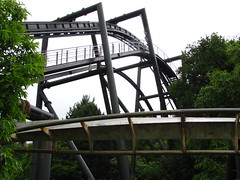 position accompanied a shift in the lighting color temperature in the station the effect is cool because we’re not required to take part in a make-believe theme park story, the ride and effects simply are.
position accompanied a shift in the lighting color temperature in the station the effect is cool because we’re not required to take part in a make-believe theme park story, the ride and effects simply are.
 “Did you know this is the world’s first roller coaster themed to brutalism?” Sam asked the first time we rolled through the bare concrete underground tunnel to the lift hill. That’s funny and fair enough, although with every other flying coaster I’ve been on owned by Six Flags or Cedar Fair
“Did you know this is the world’s first roller coaster themed to brutalism?” Sam asked the first time we rolled through the bare concrete underground tunnel to the lift hill. That’s funny and fair enough, although with every other flying coaster I’ve been on owned by Six Flags or Cedar Fair I felt lucky enough that a tunnel existed here at all. We emerge from the lift and are taken over Nemesis’ final turn, cresting to a mirrored curved drop like on its next door neighbor. At maximum speed (which isn’t all that much) the train reaches up into a 180 rollover,
I felt lucky enough that a tunnel existed here at all. We emerge from the lift and are taken over Nemesis’ final turn, cresting to a mirrored curved drop like on its next door neighbor. At maximum speed (which isn’t all that much) the train reaches up into a 180 rollover,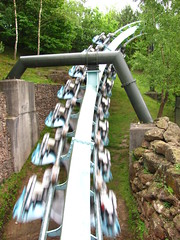 setting us back down on our backs as we navigate a left turn while looking up at the sky. We flip back down to the Superman
setting us back down on our backs as we navigate a left turn while looking up at the sky. We flip back down to the Superman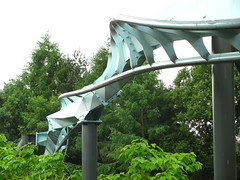 position and make a quick subterranean dive followed by a swooping helix over the midway. After a slight pause there’s a full inline twist, which I always think signifies nearing the end of the layout only to forget that an entire extra leg along the back half that remains. We hop over the brake run, swish through an s-curve, soar alongside the parking lot and re-enter the brakes. Curious as to my reaction, Sam asks me what I thought.
position and make a quick subterranean dive followed by a swooping helix over the midway. After a slight pause there’s a full inline twist, which I always think signifies nearing the end of the layout only to forget that an entire extra leg along the back half that remains. We hop over the brake run, swish through an s-curve, soar alongside the parking lot and re-enter the brakes. Curious as to my reaction, Sam asks me what I thought.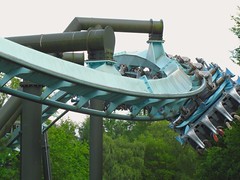
I think Wardley wanted a ride that wasn’t a typical roller coaster experience but instead offered a sensation of flying, and Air does that more successfully than any other roller coaster I can think of. Every other flying coaster of its time has a layout that’s confined to a square or triangular plot of land with nothing for the riders to look at except for dirt, footers and supports, which is fundamentally missing the point of a flying coaster. They’re supposed to have custom layouts that explore the landscape, and Air’s interaction with the midways, tunnels and its own structure, contained in an area that can’t easily be given geometric categorization, makes it the only flying coaster to actually do that. It’s slow-paced because an overload of information would be acting contrary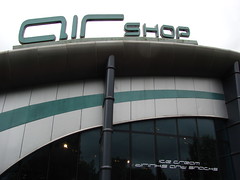 to the intended purposes this design aims to achieve. There aren’t any ‘big moments’ with show-stopping elements (pretzel loops, etc.) because you’re supposed to always be living in the moment. It’s that restraint from excess that is why I appreciate Air.
to the intended purposes this design aims to achieve. There aren’t any ‘big moments’ with show-stopping elements (pretzel loops, etc.) because you’re supposed to always be living in the moment. It’s that restraint from excess that is why I appreciate Air.
I also had to agree with Sam that, although I at least appreciated it more than he, neither of us probably liked it all too much. Sympathetic though I was to Wardley’s philosophy, I think there was a miscalculation in what would be required to achieve the emotion he intended Air to produce. Flight, movement, freedom, air… these are concepts that exist in the mind as infinite entities. You can’t truly experience the freedom of flight if you’re actively conscious that you’re in some way limited. The problem is that the amusement park setting is one of the last places that we can access that part of the psyche. We’re thinking in the quantitative realm of numbers all day; how much it cost to get here, how many minutes will it take to queue, how much a locker costs for our loose items, how few minutes it will take before we’re back in the station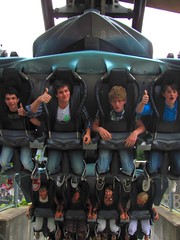 recollecting our loose items, how many more times we’ll be able to do this before the gates close. Asking guests to strap themselves in and instantly switch their minds to the qualitative realm of pure subjectivity for a minute and a half is asking a bit much; I for one wasn’t thinking, “Ah, I’m flying, I feel so free!” Rather, I was still counting off how much track was left before it was over, am I sure I’m maximizing my enjoyment of this particular sensation, am I looking the best way possible – “Oh no, there’s only one turn left, make sure I can validate to myself waiting 70 minutes within the next seven seconds!”
recollecting our loose items, how many more times we’ll be able to do this before the gates close. Asking guests to strap themselves in and instantly switch their minds to the qualitative realm of pure subjectivity for a minute and a half is asking a bit much; I for one wasn’t thinking, “Ah, I’m flying, I feel so free!” Rather, I was still counting off how much track was left before it was over, am I sure I’m maximizing my enjoyment of this particular sensation, am I looking the best way possible – “Oh no, there’s only one turn left, make sure I can validate to myself waiting 70 minutes within the next seven seconds!”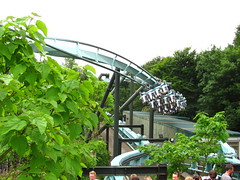
For Air to have worked the layout either needed to be at least twice as long so I didn’t feel each moment on-ride was such a valuable commodity that was slipping away from us with each passing second; or, following Sam’s critique, it simply needed to be more exciting so I would be forced to abandon those neurotic worries once onboard anyway. I would much rather prefer the first solution to the second as I imagine something essential would be lost if Air were more like Tatsu, but if I were 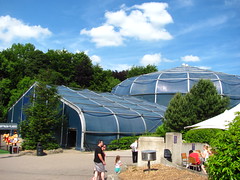 to declare Air my second favorite ride in Alton Towers (which if randomly asked would likely be my default answer), it would be because of the potential I recognized in it, rather than what was actually there.
to declare Air my second favorite ride in Alton Towers (which if randomly asked would likely be my default answer), it would be because of the potential I recognized in it, rather than what was actually there.
Not that the competition is all too great for any recognition beyond the Tower’s top ride. Apart from Nemesis, Oblivion and maybe Hex, most of the major rides in Alton Towers strike me as a compromised vision due to their strict zoning regulations. I certainly would not want to have these restrictions removed as they’re partly what make Alton Towers so unique, but I get the sense that management still hasn’t completely accepted their circumstances. When I see the landscape it’s built upon I would expect a park that’s quite elegant and tasteful, similar in approach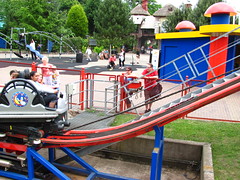 to Busch Gardens or Europa Park but without any towering rides
to Busch Gardens or Europa Park but without any towering rides and with more natural beauty. That’s sort of what Alton Towers is, but the rides are constructed with an edgy flashiness that makes me think if the circumstances were different they would more closely resemble Six Flags. Many of the logos look like they’re appealing to World of Warcraft fans, the roller coasters are all either themed to sci-fi technology or gothic horror (or are just overly colorful), with a lot of the themed areas seeming at odds with the countryside and history surrounding them. Even if the attempts at themeing are first-rate, when contrasted with the real towers and gardens and valleys they seem that much more artificial than if they had been built on a flat piece of land in Florida.
and with more natural beauty. That’s sort of what Alton Towers is, but the rides are constructed with an edgy flashiness that makes me think if the circumstances were different they would more closely resemble Six Flags. Many of the logos look like they’re appealing to World of Warcraft fans, the roller coasters are all either themed to sci-fi technology or gothic horror (or are just overly colorful), with a lot of the themed areas seeming at odds with the countryside and history surrounding them. Even if the attempts at themeing are first-rate, when contrasted with the real towers and gardens and valleys they seem that much more artificial than if they had been built on a flat piece of land in Florida.
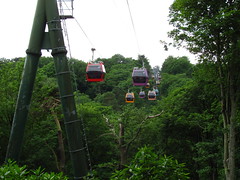 To cross from one corner of the park to the other requires either a cable car ride high above the valley, or a long walk through the gardens. This is where Alton Towers reveals its unique character, demonstrating just how impossibly large the park grounds are and reminding one that the theme park is only a relatively recent chapter in this lands history. Wandering a few paces from an Intamin rocket coaster and discovering a Victorian garden with no one but a few lost teenagers can feel quite jarring at first. Although some sort of botanic displays are mandatory at nearly any theme park, none require a quarter hour of brisk walking just to make it from one end to the other, and presumably one could spend hours enjoying the luscious green tranquility away from the rides and crowds.
To cross from one corner of the park to the other requires either a cable car ride high above the valley, or a long walk through the gardens. This is where Alton Towers reveals its unique character, demonstrating just how impossibly large the park grounds are and reminding one that the theme park is only a relatively recent chapter in this lands history. Wandering a few paces from an Intamin rocket coaster and discovering a Victorian garden with no one but a few lost teenagers can feel quite jarring at first. Although some sort of botanic displays are mandatory at nearly any theme park, none require a quarter hour of brisk walking just to make it from one end to the other, and presumably one could spend hours enjoying the luscious green tranquility away from the rides and crowds.
Sam and I elected for the brisk walk once on the second day after deciding it would be worth the few extra minutes to not take the cable car just so I could claim to have seen the gardens. We were in a hurry. As much as I may have loved to indulge in the romantic ideals such a landscape promises, hardly could I have flipped my mental switch to ‘Keats’ so long as I knew the front gates would remain open only until 6:00pm and I had more roller coasters to ride. With consistently high volume crowds each attraction could be expected to consume one hour of time to complete on average (factoring in walking time, etc.), and with 29 rides on offer but only eight hours from opening to closing during peak season (?!?!?), one might reasonably feel a bit harried and frustrated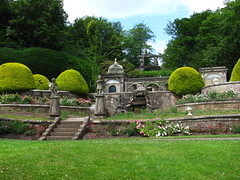 if their ambitions are anything greater than a single lap on each coaster and not much else… and then even more annoyed after being kicked out only to be left with nothing else to do for the rest of the long evening, assuming you’re booked for a second day which you pretty much have to do if you intend to do everything. This of course meant that all excess time-consuming activities had to be trimmed from our military action plan, including in-park dining and souvenir shopping… so whoever in management or the town council
if their ambitions are anything greater than a single lap on each coaster and not much else… and then even more annoyed after being kicked out only to be left with nothing else to do for the rest of the long evening, assuming you’re booked for a second day which you pretty much have to do if you intend to do everything. This of course meant that all excess time-consuming activities had to be trimmed from our military action plan, including in-park dining and souvenir shopping… so whoever in management or the town council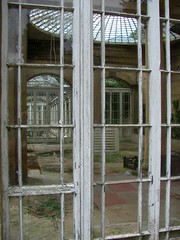 thought that requiring abbreviated park hours would also be an economically beneficial decision may have found that the joke is on them.
thought that requiring abbreviated park hours would also be an economically beneficial decision may have found that the joke is on them.
A recurring dream I used to have involved me walking into a theme park I’ve waited years to visit on a bright and sunny morning. The possibilities seem infinite, I would have so much I’d want to do… yet inevitably I would end up in some forgotten corner of the park first, become mired in some unrelated task, and eventually I’d realize it would be closing soon and I hadn’t yet accomplished anything. It needn’t take Freud to connect this dream to aspects of life not related to theme parks; but walking through this garden, backtracking after wandering a wrong way, with me checking the time wondering if we’re absolutely sure it will be possible to do both Nemesis and Thirteen in the next hour before they shut the queues, was probably about the closest I ever could have gotten to living this nightmare in the real world.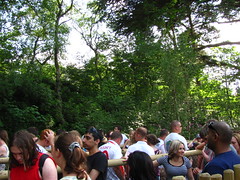
By the end of the second day I had gotten to do about everything I really wanted to do. Most of that was accomplished in the first hour of early ride time or in the very last hour before closing when the queues for the big rides would start to diminish to near walk-on conditions anyway. This meant plenty of Nemesis rerides and about five trips on Thirteen. Apart from my first four rides in Oblivion, the other rides had to be taken during peak hours,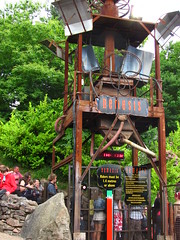 meaning between the two days I got only one more Oblivion ride, only three rides on Air, and a mere two on Rita, plus one on everything else reported upon in today’s report. The rest of the time was mostly waiting in queues, which was made infinitely more bearable by having someone to talk to. Sam, I want to thank you again so much for showing me around and providing plenty of opportunity for intelligent conversation. I suspect if I had been left to wander and backtrack the labyrinthine infrastructure without knowing where the crowd patterns were likely to hit and spending hours in line with nothing to do except calculate how far short of the theoretical capacity the coasters are actually running, my review of Alton Towers probably would have been even more cynical than it may already seem to be. (Which it really wasn’t; the best parks and rides in the world are the ones that deserve the most careful scrutiny. Holiday World learned that the hard way.)
meaning between the two days I got only one more Oblivion ride, only three rides on Air, and a mere two on Rita, plus one on everything else reported upon in today’s report. The rest of the time was mostly waiting in queues, which was made infinitely more bearable by having someone to talk to. Sam, I want to thank you again so much for showing me around and providing plenty of opportunity for intelligent conversation. I suspect if I had been left to wander and backtrack the labyrinthine infrastructure without knowing where the crowd patterns were likely to hit and spending hours in line with nothing to do except calculate how far short of the theoretical capacity the coasters are actually running, my review of Alton Towers probably would have been even more cynical than it may already seem to be. (Which it really wasn’t; the best parks and rides in the world are the ones that deserve the most careful scrutiny. Holiday World learned that the hard way.)
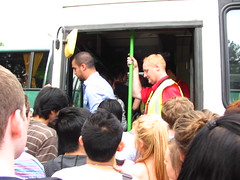 We parted ways so I could catch the soonest bus back to Stoke-on-Trent, which with only one departing every hour was quite frankly a total clusterfuck when it arrived (the bus driver literally threatened to throw everyone off the bus and leave with no one onboard if we didn’t stop pushing and shoving). There wasn’t much to do in the evening, the hotel I booked which was quite extravagant by my standards (I had no cheaper options) didn’t even have the promised wireless internet in my room. Exhausted from the non-stop traveling, I lacked the resolve to wander into town to find a decent meal and so ate at a nearby Subway. Not only did I have to pay about £9 (about $15) for a meal, but I went there again after the second day… so incapable was I to any longer give a damn.
We parted ways so I could catch the soonest bus back to Stoke-on-Trent, which with only one departing every hour was quite frankly a total clusterfuck when it arrived (the bus driver literally threatened to throw everyone off the bus and leave with no one onboard if we didn’t stop pushing and shoving). There wasn’t much to do in the evening, the hotel I booked which was quite extravagant by my standards (I had no cheaper options) didn’t even have the promised wireless internet in my room. Exhausted from the non-stop traveling, I lacked the resolve to wander into town to find a decent meal and so ate at a nearby Subway. Not only did I have to pay about £9 (about $15) for a meal, but I went there again after the second day… so incapable was I to any longer give a damn.
Hey, just to give you a heads up in case you were interested the ‘Don’t Look Down’ voice was removed years ago due to a court battle about noise levels in Alton. The voice ‘made more people scream’ so it got removed, as Oblivion is the closest ride to the village.
“…if I were to declare Air my second favorite ride in Alton Towers it would be because of the potential I recognized in it, rather than what was actually there.”
I’m finding it hard to believe what I’ve just read. For years I have tackled with the prospect of writing a review for Air, a ride I have unashamedly labelled as my favourite. Although the shape of such a review has never taken form the opinion that the rides potential is powerful enough to outweigh its downfall has always been the base of my opinion. I find myself shocked to see these words appear here, especially as I believed the ride to undergo a similar slating many others have given it.
I am glad that such thought has been put into words in a way that I never could. Thank you.
Hex is another interesting point as I both strongly agree while simultaneously disagree with your view. In many ways you’re initial response mirrors my own. I couldn’t understand what all the fuss was about and wasn’t affected by the rotating chamber or shoehorning of a scientific laboratory.
That was 7 years ago and in that time my perspective has changed from seeing just another ride to a theme park classic. I can’t be sure why but there is something about the experience that sticks. There’s a feeling and atmosphere that is unique which underlines the experience, as if your mere presence is somehow a part of the legend itself. There’s more to Hex that has so far escaped analysis, exactly what this pulling power is could be the key to great and artistic rides of tomorrow.
Doesn’t surprise me that’s the reason for the removed voice, I should have known. Is that the reason some of the cars don’t stop at the top for very long either? I think Sam told me it was because the catch dogs had actually worn down so that they didn’t engage with the chain anymore but I found that sort of incredulous. Can anyone else verify that?
I’d like to do Hex again anyway because I honestly couldn’t recall it that well, I was having to do a bit of online research get the details of the ride experience correct. In that light, instead of trying to do a complete ‘serious’ analysis when I was far from qualified for doing so, I thought my words would be better served to present a wry, satirical story which did highlight a few of the critiques I did remember. That said… I’m pretty sure the only thing that might be improved on a second ride is the sense of atmosphere, but I can get that much cheaper depending on the day’s weather. Mad Houses only loose more of their effect with each repeat ride, and from everything I recall and have read about the story, I found it to be disappointingly weak. If Sam hadn’t been telling me that parts of the story were actually true, it wouldn’t have been any different to me than a slightly classed-up version of the same tired narrative that’s recycled over and over again at Universal Studios and its imitators. Just a warning, however, my standards of what constitutes ‘good storytelling’ are pretty strict. Even if it was The King’s Speech or Inception I would still be calling it out.
“A recurring dream I used to have involved me walking into a theme park I’ve waited years to visit on a bright and sunny morning. The possibilities seem infinite, I would have so much I’d want to do… yet inevitably I would end up in some forgotten corner of the park first, become mired in some unrelated task, and eventually I’d realize it would be closing soon and I hadn’t yet accomplished anything.”
I have had amusement park and rollercoaster dreams fairly regularly for almost fifteen years now, and in every single case, without exception, I have been at an amazing park (they never quite correlate with reality, even if the name and weather are both right) and still somehow failed to ride anything. It’s never made explicit – the rides are not broken down, and I am not barred from riding – but it just takes so long to do anything that I never get on a single attraction. The strangest thing about it is that I am not greatly vexed by this at the time. I’m not chomping at the bit or hurrying others along. I just am aware when I wake up that I didn’t get to ride anything. It is almost as if I have the demo version of Rollercoaster Dream™ and haven’t upgraded the license to include on-ride simulations.
I’m perversely glad that someone else has been routinely and frustratingly thwarted.